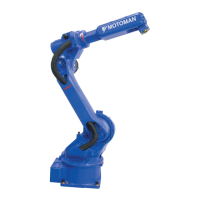6 Conveyor Tracking
6.7 Developing a Conveyor Tracking Application
6-23
168542-1CD
168542-1CD
MLX200 Software and
Operations
Dynamic Load-balancing
Dynamic Load-Balancing refers to the process of using the KeepInQueue
and NewRobotQueue variables in the Conveyor Sync Stop instruction to
dynamically handle the object queue. The use of these variables was first
described in Section 6.7.1.2 “MLxRobotConvSyncStop Instruction”. This
section will show how these variables can be used to implement several
application scenarios.
First, consider the example shown in Fig.6-26 "Two Robots on One
Conveyor Example" with two robots on one conveyor. In the previous
section, we introduced how the parts could be routed between the two
robots using Pattern-Based Distribution. Another way to handle this
application would be to route all parts to Robot 0, and then have Robot 1
pick any parts that the first robot missed. To do this, the application logic
could check the Sts_OL bit from Robot 0's Conveyor Sync Start
instruction. If this was set to 1, the Conveyor Sync Stop command could
be called with KeepInQueue=1 and NewRobotQueue=1. This would move
the part to Robot 1's queue where it could be picked further down the line.
Fig. 6-26: Two Robots on One Conveyor Example
It is also possible to combine Pattern-based Distribution and
Dynamic Load-Balancing. For example, in the above
scenario, a pattern of 2 parts to Robot 0 and then 1 part to
Robot 1 could be established, with Robot 0 still moving the
parts it missed to Robot 1.

